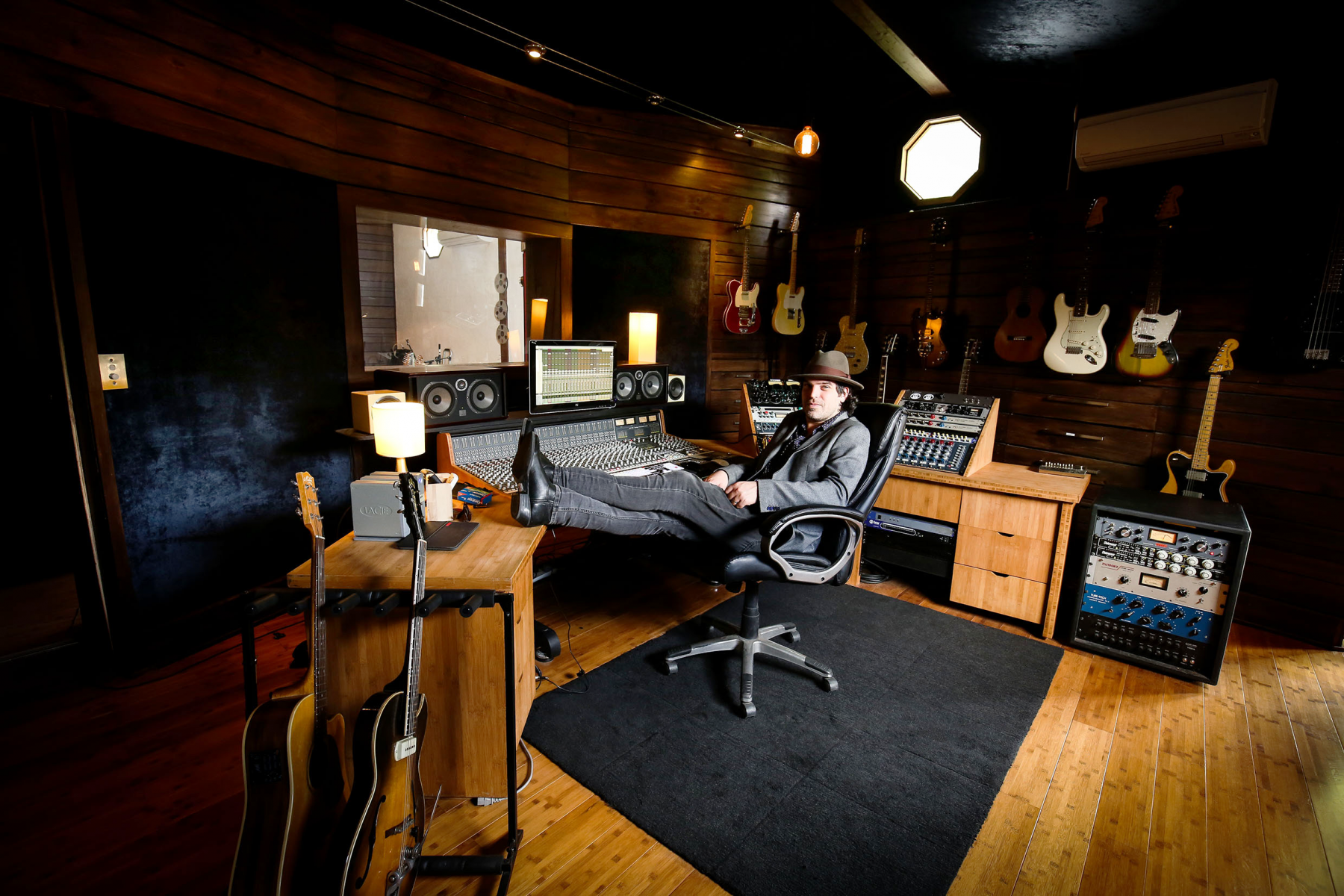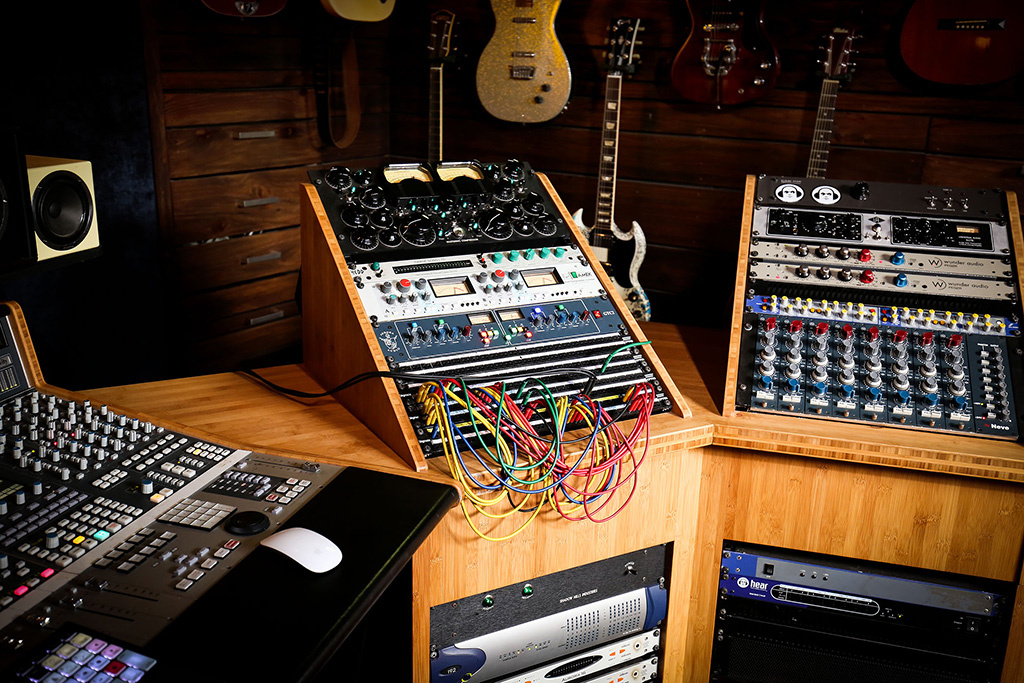
Red Moon Rising
At Red Moon Studios, every day is different. Hip hop with Illy, tracking a record live with The Cat Empire or John Butler, or composing an award-winning TV series, it’s no different for multi-talented Jan Skubiszewski.
Peter Weir’s film Picnic at Hanging Rock is one of those monolithic, unimpeachable icons of Australian creativity. Whether you like it or not, it doesn’t matter. It’s become so legendary that like the rock itself, it’s unmovable, fixed into the landscape of Australian art.
So what do you do when you’re asked to mess with the untouchable? When Jan Skubiszewski was commissioned to compose the music for a Foxtel series of the same name, he was wondering a similar thing. The pan pipes theme of the original were ringing crystal clear in his mind. They were as integral to Weir’s chilling weirdness as the dubbed voices and soft focus of the wedding veil draped over the camera lens. But… don’t tell anyone… he never really liked the score. Naturally, he was relieved when a single stipulation came through from the producers: steer clear of pan pipes.
BETWEEN A ROCK & A GORGEOUS PLACE
Jan Skubiszewski is pretty familiar with the actual Hanging Rock. It’s close enough to his home at the doorstep of the Macedon Ranges that his young family goes on the odd walk there. He’s also familiar with well-known Australian scores. His father, Cezary, has been composing for decades, writing scores for films like Red Dog, The Sapphires, and Two Hands (which he co-wrote with Jan). He and Jan collaborated on the score for Picnic at Hanging Rock, too.
Jan’s route to Hanging Rock, both physically and musically, has not been without its serendipitous moments. Growing up in the Otways, he always had a desire to see his kids experience the beauty of nature, but it was always going to take the right place. Then a couple of years ago he was invited to attend an APRA SongHubs session at Jon Hume’s studio in South Gisborne. Originally a horse stable, the Hume brothers, who played together in Evermore, had converted it into a studio and residence. Jon had since bought the others out to use it as his personal space.
Jan didn’t get to experience the full beauty of the property because, “it was the middle of winter” and during the SongHubs sessions he was working flat out in the studio control room. Still, it was enough of a taste of the country life for him: “I said, ‘if you ever want to sell, let me know.’ Six months later they did, so my wife and I bought it off them.” It’s now called Red Moon Studios.

FINE ART OF MUSIC
Now 37, despite his father’s influence, Jan wasn’t always convinced his path would take him in a musical direction. At 19, he was actually studying Fine Arts at the VCA where he found himself gravitating towards the jazz musicians because he “thought they were a lot more fun.”
Jan had learnt the craft in his father’s converted garage studio. It centred around Logic with a 32-track system. The interface was connected by SCSI leads, which would fray over time. When it was only good for eight channels, Cezary kicked it Jan’s way.
Playing in bands with the VCA crowd meant he started working with producers, including Andy Baldwin, a popular producer who worked on lots of Australian records as well as for internationals like Björk. “Andy called me once during the school holidays in about 2001 and told me. ‘I’m going up to Byron Bay to record a band. It’s going to be about three months, they’re called The Cat Empire. It’s going to be their debut record.’ We went up onto this old macadamia farm and converted a farmhouse into a studio. We recorded the record, and it went double platinum.”
HOOKED
On the drive home Baldwin let Jan know about an independent record label owner who was looking for an in-house songwriter/producer. It was a place called Marlin Records, owned by a Sri-Lankan born businessman, Marlon Goonawardana. “I worked a lot with Daniel Merriweather, during that time,” said Jan. “He was the same age as me. He later worked a lot with Mark Ronson, and had his own record that went to No.2 in the UK. He and I, and another friend Phrase, who was a rapper, we all just lived in the studio for a couple of years and got completely absorbed with how it all came together.”
HATS OFF
Over the years, Jan has kept his hand in a number of areas. On any given day he can draw on all facets of his production and composition background. There’s the film and television work, and he continues to play live, these days as a keys player for Dan Sultan; though along the way he started a band with Harry, from the Cat Empire, called Jackson Jackson. On the record production side he still works with The Cat Empire, and lately he’s been producing albums for John Butler, as well as an Alabama Shakes-esque soulful record for Karise Eden. Following on from his largely hip hop and pop work at Marlin, directly after our interview, Jan was due to start a session with Illy and songwriter, Cam Bluff. “I’m writing pretty much every day at the moment,” said Jan. “Something my dad really drilled into me is to get into your creative space every day. Even if it’s just for an hour. If you get in there and scribble something, there’ll be a lot of days you don’t create great content, but it means the one little idea or melody you came up with that was good will eventually find a home. Things will come together, but it only happens if you continually make yourself available to it. That’s just the discipline.”
Despite telling Marlon he knew how to work the studio, Jan had no idea when he first started. “It was a Friday and I was supposed to start on Monday,” Jan recalled. “I asked if I could grab the keys over the weekend to check the lay of the land. I spent the next 48 hours with every manual open of every piece of gear, which I had no idea how to use. I didn’t know how to use a patch bay, so I was manually patching things, and calling my mentors, like Andy and Adam Rhodes, who guided me through it. By the time Monday morning came, I had the Akai MPC coming through and recording to Pro Tools, and I had a vocal chain. From there it was a case of ‘fake it until you make it’, and I got away with it.
“I really thank Marlon, who bankrolled this hopeless bunch of kids and gave us the keys to a very expensive, well-kitted out studio on Greville St in Prahran, and told us to go for it.”
After Marlin, Jan bought a studio in Hawthorn East off Barry Palmer from the Hunters & Collectors called Way of the Eagle Studios. As part of the sale he also bought some of the gear, including a TL Audio Tubetracker and Neve preamps. “I was there for seven or eight years in a dark cave,” Jan said. “It was an awesome studio, but there was no natural light. I’d get there in the morning, leave at night, and it would be dark and rainy. I’d feel like I wasn’t part of this world.” He had partnered up with Chris Scallan, who took over the whole studio when Jan left, turning it into more of a post-production/film house.
He bankrolled this hopeless bunch of kids and gave us the keys to a very expensive, well-kitted out studio, and told us to go for it

SCORING IN BUNCHES
Jan doesn’t draw too much of a distinction between his different jobs. “In a way, film and television composition is similar to record production,” he explained. “You’ve really got to listen to what the director’s vision is then apply your aesthetic to that. Rather than slapping your aesthetic on it and saying, ‘It’s gotta be trap beats the whole way!’ You won’t get very far doing that. I’m pretty sure you’ll just get fired.”
Jan explained his process, which usually starts with a script or the first cut: “With something like Picnic at Hanging Rock, there wasn’t that much dialogue, especially in some of the earlier episodes. It’s built around this mood, and a sense of space, and mystery. Without the music or any sound designing it just looks like a bunch of girls wandering around in the bush. Often they give you a direction to steer — like ‘sad, but tense’ — then you’ll trial something. People often need to hear something to realise what they do or don’t like. It’s pretty rare they’ll write the draft off. Usually they’ll use it as a springboard to discuss the dramatic pulse or beats they want to hear.
“When you all work together and get it right in the end, it’s pretty cool. The only thing we were told was to steer away from the original music, because it had this very iconic pan pipe theme. They didn’t want to just rehash that, which was good, because I wasn’t in love with the original music.”
ENGINEERING BLISS
While he got into record production early on, the engineering side of the job never appealed much to Jan, “until I realised engineering wasn’t just a means to an end, but was a complete palette of colour you could inject into your recordings. Then I started blissing out. I realised it was a really creative way to make music and enhance the production.”
These days Red Moon Studios is Jan’s playground. He’s often working by himself, but doesn’t resort to working in the box. It’s one of the reasons he still prefers to use Pro Tools, “because it’s more of a tape machine to me. You have to create a great sound into it”.
While he’s not adverse to digital — using NI’s Session Strings and Embertone’s Intimate Strings among others — he tries to incorporate as much analogue gear and physical playing as possible. “I really love things that have elements of human calamity in them. That’s why I love my studio,” said Jan. “The SSL AWS console flips from being a DAW controller, to being an analogue console, with the flick of a button. That hybrid between analogue and digital is the perfect way for me to work.”
He’s got some great gear around the room, including a collection of guitars that aren’t all his. “It’s the cool thing about owning a studio, it becomes a dumping ground for all your mates’ bits of gear their wives don’t want in their houses,” laughed Jan. “Three of these guitars are Dan Sultan’s, he used to keep a lot of his guitars here because he thought it was safer.”
Some of the tasty bits include a Neumann U87, which he sends into a Neve 1073, and a mono side of the Shadow Hills Compressor for Illy’s vocals. “I used to always use the 1176 or the Retro, but then I started using the Shadow Hills and I can’t go past it,” explained Jan. “Someone can slam into it and it still sounds musical. You don’t lose all your gain. It has a great way of grabbing dynamic vocals that’s really cool.”
DRUMMING UP THE COURAGE
When Jan found that engineering bliss later in life, he immediately started tackling his biggest fear. He’d long felt insecure about recording drums, so would farm them out to another engineer. Coming up through the hip hop beat-making scene at Marlin — where he exclusively focused on soul breaks and drum samples for years — he never quite felt other engineers delivered the colour he was after. These days it’s turned into one of his biggest engineering pursuits.
“Marlin gave me an intense love of drums that weren’t clinical, generic or hi-fi sounding,” said Jan. “It was really only when I started recording them myself that I worked out how to do it with different mic techniques and different rooms. It was the hardest thing to learn, but easily the most fun aspect to get right.
“How I approach it depends on what I’m going for. Sometimes I just really like a mono overhead and often don’t mic the toms. I’ve got this old AKG D1200, it’s kind of a 57-ish mic that’s brighter. I often use it on the snare taped with an AKG C451 condenser. Then just add a kick, a mono room, and mic up the bathroom next door and I’ll just try and get a huge vibe out of that.
“On the flip side, there were a couple of songs on the John Butler record where I was running out of mic stands. We were just trying everything — mics up in the ceiling, multiple overheads, all of that. In the end, the drum sound is so huge, but it’s not hi-fi. We were really wanting that Bonham vibe where it still feels really tough, not clinical.
“Once you learn a few different setups, you can start applying them to the music you’re making. For the Karise Eden soul sound, I used a really minimal setup; mono overhead, no toms, kick, snare — a 57 through a Neve 1073 and Distressor — and some rooms. Then I’ll just really spank it with compression and get a lot of the colour from the booth.
“I usually put a mic behind the drummer’s arse, or behind their head from their perspective. Because their body usually kills a bit of the sharp tops of the cymbals, you can get the snare quite explosive without having too much wash at the top end.
“On previous Cat Empire records I’d done, I like the way the drums sounded, but sometimes too compressed. This time, I wanted to make them breathe, because I knew a lot of the other elements would be quite treated. In that way, it was creating a natural sound, which made way for other things to be more out there. You’ve just got to adapt to what things need.”
























RESPONSES